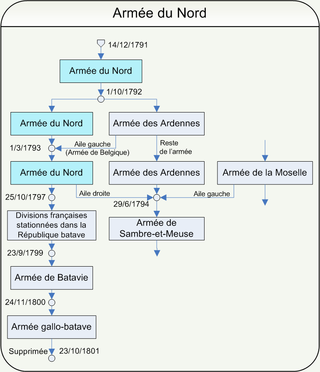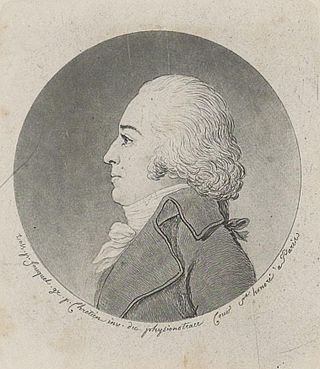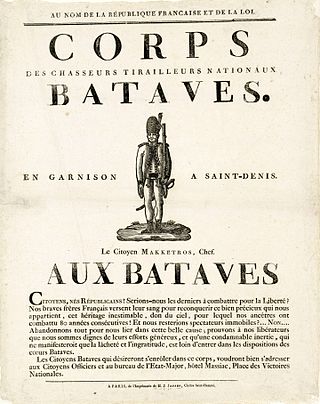
Charles-François du Périer Dumouriez was a French military officer, minister of Foreign Affairs, minister of War in a Girondin cabinet and army general during the French Revolutionary War. Dumouriez is one of the names inscribed under the Arc de Triomphe, on Column 3.

The Battle of Jemappes took place near the town of Jemappes in Hainaut, Austrian Netherlands, near Mons during the War of the First Coalition, part of the French Revolutionary Wars. One of the first major offensive battles of the war, it was a victory for the armies of the infant French Republic, and saw the French Armée du Nord, which included many inexperienced volunteers, defeat a substantially smaller regular Austrian army.

The Battle of Neerwinden saw a Republican French army led by Charles François Dumouriez attack a Coalition army commanded by Prince Josias of Saxe-Coburg-Saalfeld. The Coalition army of the Habsburg monarchy together with a small contingent of allied Dutch Republic troops repulsed all French assaults after bitter fighting and Dumouriez conceded defeat, withdrawing from the field. The French position in the Austrian Netherlands swiftly collapsed, ending the threat to the Dutch Republic and allowing Austria to regain control of its lost province. The War of the First Coalition engagement was fought at Neerwinden, located 57 kilometres (35 mi) east of Brussels in present-day Belgium.
The French Revolutionary Wars began on 20 April 1792 when the French Legislative Assembly declared war on Austria. This launched the War of the First Coalition.
The French Revolutionary Wars re-escalated as 1793 began. New powers entered the First Coalition days after the execution of King Louis XVI on 21 January. Spain and Portugal were among these. Then, on 1 February France declared war on Great Britain and the Netherlands.

David Hendrik, Baron Chassé was a Dutch soldier who fought both for and against Napoleon. He commanded the Third Netherlands Division that intervened at a crucial moment in the Battle of Waterloo. In 1830 he bombarded the city of Antwerp as commander of Antwerp Citadel during the Belgian Revolution.

The Army of the North or Armée du Nord is a name given to several historical units of the French Army. The first was one of the French Revolutionary Armies that fought with distinction against the First Coalition from 1792 to 1795. Others existed during the Peninsular War, the Hundred Days and the Franco-Prussian War.

The siege of 's-Hertogenbosch also known as the siege of Bois-Le-Duc was an action in 1629, during the Eighty Years' War and the Anglo–Spanish War in which a Dutch and English army captured the city of 's-Hertogenbosch. The city had been loyal to the King of Spain since 1579 and was part of the Spanish Netherlands.

Pieter Philip Jurriaan Quint Ondaatje was an illustrious Dutch patriot and influential revolutionary politician at the end of the 18th century. Ondaatje is regarded as a pioneer of Dutch democracy. When Utrecht was besieged by States army troops he allied himself with Rhinegrave von Salm, entrusted with the defence Holland and Utrecht. At the end of 1787 he lived as refugee in Brussels and French Flanders. From 1795 he served the Batavian Republic and in 1806 the Kingdom of Holland. Up to the Hundred Days he worked in Paris.

The Low Countries theatre of the War of the First Coalition, also known as the Flanders campaign, was a series of campaigns in the Low Countries conducted from 20 April 1792 to 7 June 1795 during the first years of the War of the First Coalition. As the French Revolution radicalised, the revolutionary National Convention and its predecessors broke the Catholic Church's power (1790), abolished the monarchy (1792) and even executed the deposed king Louis XVI of France (1793), vying to spread the Revolution beyond the new French Republic's borders, by violent means if necessary. The First Coalition, an alliance of reactionary states representing the Ancien Régime in Central and Western Europe – Habsburg Austria, Prussia, Great Britain, the Dutch Republic, Hanover and Hesse-Kassel – mobilised military forces along all the French frontiers, threatening to invade Revolutionary France and violently restore the monarchy. The subsequent combat operations along the French borders with the Low Countries and Germany became the primary theatre of the War of the First Coalition until March 1796, when Napoleon took over French command on the Italian front.

The Batavian Revolution in Amsterdam refers to the transfer of power in the city of Amsterdam on 18 January 1795 to a Revolutionary Committee of the new Batavian Republic. The same day the stadtholder of the Dutch Republic, William V, Prince of Orange fled the country. Amsterdam was the first city that declared itself in the Batavian Revolution that brought about the Batavian Republic.

The Batavian Legion was a unit of Dutch volunteers under French command, created and dissolved in 1793.

The siege of Lille saw a Republican French garrison under Jean-Baptiste André Ruault de La Bonnerie hold Lille against an assault by a Habsburg army commanded by Duke Albert of Saxe-Teschen. Though the city was fiercely bombarded, the French successfully withstood the Austrian attack in the action. Because the Austrians were unable to completely encircle the city, the French were able to continuously send in reinforcements. After news of the French victory over the Prussians at Valmy, Albert withdrew his troops and siege cannons. The next battle was at Jemappes in November. The Column of the Goddess monument was completed in 1845 to commemorate the siege.

At the Battle of Peyrestortes in the War of the Pyrenees, soldiers of the First French Republic defeated a Spanish army that had invaded Roussillon and was attempting to capture Perpignan. The Spanish army of Antonio Ricardos had occupied part of Roussillon and made an abortive attempt to seize the fortress of Perpignan in July 1793. At the end of August, the Spanish commander sent two divisions on a sweep around the western side of Perpignan in an attempt to isolate the fortress and choke it off from resupply. After an initial Spanish success, the French army commander Hilarion Paul Puget de Barbantane, lost his nerve and fled from the area.
Louis-Charles de La Motte-Ango, vicomte de Flers joined the French Royal army and rose in rank to become a general officer in the French Revolutionary Wars. After serving in the Austrian Netherlands, he was appointed to command the Army of the Eastern Pyrenees. His army suffered several defeats in May and June 1793, but he rallied his troops to win a defensive victory at the Battle of Perpignan in July. The all-powerful Representatives-on-mission arrested him in August 1793 for a minor setback and sent him to Paris under arrest. The Committee of Public Safety executed him by guillotine on trumped up charges in the last days of the Reign of Terror. De Flers is one of the names inscribed under the Arc de Triomphe.

Paul Charles François Adrien Henri Dieudonné Thiébault was a general who fought in Napoleon I's army. During his military career he wrote a number of histories and memoirs, the last of which were published in 1895.

The siege of Condé saw a force made up of Habsburg Austrians and French Royalists commanded by Duke Ferdinand Frederick Augustus of Württemberg lay siege to a Republican French garrison led by Jean Nestor de Chancel. After a blockade lasting about three months the French surrendered the fortress. The operation took place during the War of the First Coalition, part of a larger conflict known as the French Revolutionary Wars. Condé-sur-l'Escaut, France is located near the Belgium border about 14 kilometres (9 mi) northeast of Valenciennes.

The Battle of Aldenhoven saw the Habsburg Austrian army commanded by Prince Josias of Saxe-Coburg-Saalfeld attack a Republican French force under René Joseph de Lanoue. The Austrians successfully crossed the Roer River and engaged in a cavalry charge led by Archduke Charles, Duke of Teschen which routed the French and inflicted heavy losses. The War of the First Coalition battle occurred near Aldenhoven, a city in North Rhine-Westphalia, Germany located about 55 kilometres (34 mi) west of Cologne.

The siege of Maastricht was a failed siege of the city of Maastricht by the forces of the French First Republic from 6 February to 2 March 1793, marking the final action of the 1793 campaign of the War of the First Coalition. The city was successfully defended by the Dutch garrison with the assistance of a small band of French Royalists.

The siege of Nijmegen occurred from 27 October to 8 November 1794 during the Flanders campaign of the War of the First Coalition. It was the last major military confrontation between the forces of the Revolutionary French First Republic and the reactionary First Coalition of European monarchs including William V, Prince of Orange, before the fall of the Dutch Republic in January 1795, which William had ruled as hereditary stadtholder since 1751. As commander-in-chief of the Dutch States Army, his indecision, several changes of mind and lack of coordination with his Anglo-Hanoverian, Hessian, Prussian and Austrian allies contributed to the eventual surrender of Nijmegen to the French revolutionaries.



















